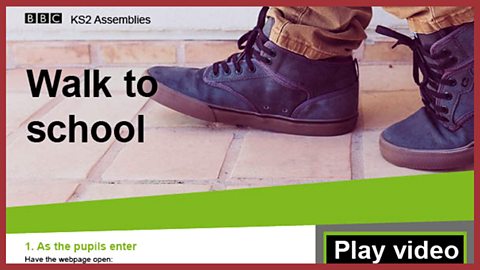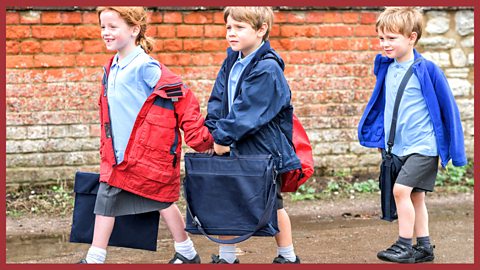In short...
Themes: society, citizenship, rights and responsibilities, rules, laws, justice.
Summary: This assembly could be scheduled during - w/c 20 May 2024 - or International Walk to School Month. According to campaigners : 'A generation ago, 70% of us walked to school - now it's less than half.' Walking to school is a good idea for all sorts of reasons⦠so why do so many pupils arrive by transport⦠and what can be done to encourage safe walking?
Resources: the and an image of .

The video
Pupils Evie and Shaeya discuss how they get to school. Shaeya walks, but Evie comes in the car. Only 40% of their classmates come on foot, even less than the national average of 46%. The girls meet Aare Puussaar, from Newcastle University, who helps them test air pollution caused by traffic near their school. They are shocked to discover rush hour air pollution levels are quite high, with small particles from car exhausts that are bad for our lungs. The girls find pollution levels drop when there is less traffic. They agree with their deputy headteacher, Brian Ostro, that parents often have good reasons for bringing their children to school by car. But we will all be fitter and our streets less polluted if we walk to school whenever we can.
Duration: 4' 38"
End of speech: 'I'm going to talk to my parents to see if we can make it happen.'
Video questions
- What percentage of pupils usually walk to Evie and Shaeya's school? (40%)
- What is the national average for children walking to school? (46%)
- Which university is air pollution researcher Aare Puussaar from? (Newcastle University)
- Why does Aare Puussaar say buses are good for the environment? (He says: 'It's better to have 60 people on one bus than 60 cars on the road'.
- What is 'rush hour'? (The time in the morning when most people travel to work or school and the time in the evening when they go home again)

Key links
Download / print the assembly framework ready for use

Click to display the image full-size


Suggested framework
1. Entry music
You could play 'Stop! Look! Listen! Think!' a song from The British Council about safely crossing the road (see 'Related links' below).
2. Introduction
Display the image of children walking to school (see 'Key links'). Encourage the children to listen closely to the entry music and to join in with the song. You might choose children to stand at the front and model the 'Stop! Look! Listen! Think!' moments, as if they were about to cross a road. Explain that today's assembly is about Walk to School Week, when children and families are encouraged to take up the challenge to come to school on foot. Ask: 'Why do you think it might be a good idea to walk to school?' Gather the pupils' responses (eg 'It keeps us fit' / 'It's good to get out of the car' / 'It cuts down traffic and pollution'. Introduce the video with: 'Here's what happened when two pupils set out to discover more about walking to their schoolβ¦'
3. The video
Play the video. The duration is 04' 38" and the final words are: 'I'm going to talk to my parents to see if we can make it happen.'
4. After the video
Ask pupils to close their eyes and picture the last walk they took. Was it to school, or somewhere else? What did they see on the way? How did it feel to be outside?
5. Time to talk
You could ask some pupils to describe their journey to school, or a favourite walk they have taken. Prompt them with questions: eg 'Did you see or hear anything interesting?' / 'How did it feel to be outside?' Guide the children to think about how good it can feel to get outdoors, even if the weather isn't great. 'Walking helps us notice and value the world around us. And we always feel a little better when we've had the chance to go outside and see the sky.'
Ask: 'If we all agree walking to school is a good thing to do, why don't more of us do it? Why do we need a special week to remind us?' The pupils might suggest it's sometimes not practical for parents to take their children on foot; sometimes it might upset family routines and make people late and sometimes parents are worried about children being safe when walking.
On the safety point, ask pupils: 'What rules should we follow when we cross the road?' and make a list together - eg: 'Use a crossing if there is one' / 'Never cross between parked cars' / 'Stay close to an adult if you are with one' / 'Look left and right all the time you are crossing and listen out for cars too' / 'Wear something bright and reflective if you're walking in the dark' / 'Hold young children by the hand if you are crossing with them' / 'Keep your dog on a lead when you cross the road.'
Conclude with: 'Walking to school is good for us. And because it cuts pollution, it's good for our planet too and all the animals and plants we love to see.'
6. Opportunity to sing
If your assembly is to include a song this would be a good time for it. Suggestions from ΒιΆΉΤΌΕΔ collections below.
7. Opportunity to reflect
Walking to school is good for us and good for our wonderful planet, its plants and its animalsβ¦
Even if you can't walk to school, try and make time to get outside and walk somewhere every day, to breathe the fresh air and to see the skyβ¦
Where will you walk today?
8. Opportunity for prayer
Use your standard form of address ('Dear God', 'Lord Jesus' etc) and:
We thank you for the world we walk through, the clean fresh air and the sky above our heads.
Help us to take time to notice our world and to take good care of it.
Amen.

Suggested songs
Song: 'He's got the whole world' (Come and Praise, no 19. Vocal version)
Heβs got the whole world, in His hand,
Heβs got the whole wide world, in His hand,
Heβs got the whole world, in His hand,
Heβs got the whole world, in His hand.
Heβs got the wind and the rain, in His hand,
Heβs got the wind and the rain, in His hand,
Heβs got the wind and the rain, in His hand,
Heβs got the whole world in His hand.
Chorus
Heβs got the sun and the moon, in His hand,
Heβs got the sun and the moon, in His hand,
Heβs got the sun and the moon, in His hand,
Heβs got the whole world in His hand.
Chorus
Heβs got the plants and the creatures, in His hand,
Heβs got the plants and the creatures, in His hand,
Heβs got the plants and the creatures, in His hand,
Heβs got the whole world in His hand.
Chorus
Heβs got everybody here, in His hand,
Heβs got everybody here, in His hand,
Heβs got everybody here, in His hand,
Heβs got the whole world in His hand.
Chorus
Song: 'All things bright and beautiful' (Come and Praise, no 3. Vocal version)
All things bright and beautiful,
All creatures great and small,
All things wise and wonderful,
The Lord God made them all.
Each little flowβr that opens,
Each little bird that sings,
He made their glowing colours,
He made their tiny wings:
Chorus
The purple-headed mountain,
The river running by,
The sunset and the morning,
That brightens up the sky:
Chorus
The cold wind in the winter,
The pleasant summer sun,
The ripe fruits in the garden,
He made them everyone:
Chorus
He gave us eyes to see them,
And lips that we might tell
How great is God Almighty
Who has made all things well:
Chorus

Related links
